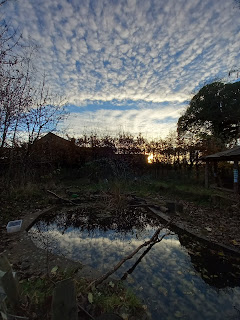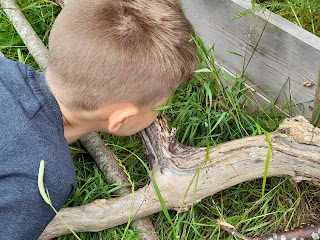The Outdoor Curriculum
At the risk of repeating myself - Forest School is only one part of outdoor learning. Currently we're running 'Forest School Lite'. The Forest School Leader is running the sessions, but it's not Forest School format, or Forest School length... So is it Forest School?
The bonus of this format is that 3 sessions can be fitted into one day, and across four days twelve classes get to venture outside and begin to explore the area with Forest School rules and ethos and freedom. In our particular setting we can also rotate use of different areas across our grounds. Each lends itself to various learning experiences, different environmental uses and different physical spaces.
We started the new school year in our Wildlife Garden. Almost half the space is very tall saplings that give the appearance of woodland, the rest is grass. There is a pond, edged in concrete and a huge mature sycamore. At the start of 2020 we had a round house built alongside it, complete with fire pit and benches to allow classes of up to 30 to sit comfortably inside. The entire area has a perimeter hedge and is self contained within.Over a fortnight our 12 classes discussed and built, created and adapted areas to ensure appropriate habitats for our amphibious visitors, and our mammal visitors were available. The classes enjoyed the physical building and exploring, as well as the opportunity to experience the wildlife first hand. Their ideas frequently showed prior knowledge that perhaps no one would've ever had the chance to expose in any other circumstance, and their execution of practical creating proved many a hidden skill! They have ownership of this Garden space now and are interested in new developments as they happen.
Their curiosity and sense of adventure helped Chartham complete a couple more of the RSPB Wild Challenges and earned us the Silver Award. Each class and year group had the opportunity to join in so it was very much a school effort.
This current Forntnight we are based in an area we refer to as the 'Mud Kitchen'. Mainly because there is a huge mud kitchen right next to the Basecamp! But that is not all there is.There are lots of bricks the children can use to build, there are sticks of all sizes, plus bushes that feel like dens and are natural tunnels. One of the mature trees is good to climb into, and there is space to be quiet and still if you choose. Obviously bug hunting and bird-watching can happen anywhere, and this area feels very much like being in the woods as opposed to being in a garden. This also makes it several degrees colder here, and always quite shaded.
Many activities remain the same, but new ones are introduced also. This can be logistically awkward as Year 6 and Year 1 may be having consecutive sessions, and the opportunities available have to reflect their abilities as well as their interests.
Access to information about birds & bugs, and trees & leaves, allows independent discovery, as well as the opportunity to ask questions of adults. Watching squirrels, listening for the Robin, are things the children may never get to do anywhere else. The excitement of discovering a community of slugs nestled in a tree is something to behold!
Both The Wildlife Garden and the Mud Kitchen Area are spaces that teachers will use for outdoor learning with their classes also. This is one of the reasons the pupils are learning basic Forest School rules, how to respect their outdoor areas and what is expected of them within these 'Outdoor Classrooms'. Most rules are there for safety, but some are there to ensure care and consideration for wildlife and the environment.On Tuesday the CLOtC ran a useful webinar regarding Outside Learning, they are an affordable resource for most, and have plenty of useful information. Many schools have made a concerted effort to move learning outside as much as they can. In the madness of 2020 it's not just our school that has found it valuable to use outside space to help children settle back and readjust to school life after months of disruption. The Play Safety Forum has a blog out currently highlighting the Covid-19 and Children's Play research paper (you can download it from their blog). The positive impacts on the health and mental wellbeing of children (and adults) are constantly being explored, especially by the current Nature Premium movement. The possibility of using school grounds and local community spaces to deliver the curriculum outdoors is something every school needs to explore.
There are many hurdles, being in the countryside doesn't mean having access to it. If you are a child you need adults to pave the way for for such exploration. Just as we have learned that childhood in a city of museums and galleries doesn't automatically mean families utilise them, having parks, open spaces, woodland, rolling hills, or even the coast on the doorstep does not necessarily mean children will spend any meaningful time in those spaces.
A small grassed area, or large containers on concrete can create a space for nature to be developed and nurtured to allow hands on access to the curriculum as well as open up new learning opportunities that support it and extend it. The Government is supporting Nature Friendly Schools alongside The Wildlife Trusts in developing their outdoor space to it's best advantage.
The photos used this week include staff joining in at Forest School, sharing enthusiasm, fun, curiosity, knowledge, skills, and the outside environment. This offers a new aspect to the way the class views the adults who teach them, and often allows a different kind of connection. It's not often in a school day you can sit for 10 minutes and listen to a five-year-old explain his extended family and their life on a farm! Or have an eight year old talk about their last school and seriously discuss what is better now, and what they miss about then.
Taking learning outside frequently alters the feeling within a class. Each has it's own characters, noisy ones, quiet ones, eager ones, reluctant ones, popular ones, solitary ones.... Once outside often these character traits alter. A new environment allows for a new perspective, different life experiences come into play, different types of prior knowledge become useful, different skills are required. Often children's persona alters when they have space, when things suddenly seem familiar, or unfamiliar, when their comfort zone vanishes - or when it arrives. Plus when children see they have some control over their learning their attitude starts to shift. Week 4 of Forest School Lite, and a Year 6, new to the school, who has struggled to settle at times, arrived with a Bug Box and a mission to find some. This was infectious, and many joined in. This session, week 4, hour 6 of this kind of learning, and a relaxed child emerged, eager to ask questions, happy to start a trend, involved with peers, interested in learning, and discussing with adults how to take this learning forward...
There are many ways to introduce Outdoor Learning to a school. Taking on the RSPB Wild Challenges, The Woodland Trust Green Tree Awards, and the RHS Campaign for School Gardening all allow you to go at your own pace, to choose your activities, and give a structure to how you progress.The Royal Forestry Society runs a Junior Forester Award and Forestry England offer spotters guides and activity sheets that can be used on a visit, or in a park, or adapted locally. These are all easy access ways to begin outdoor learning, with much of the planning and some of the prep already completed for you!
However it is the attitude of the staff involved that will make the biggest difference! You can set up a mud kitchen on concrete, with a bag of soil, a jug of water, and second hand pots and pans. Children can make mud ink, mud soup, and mud cake, and describe how they get the correct consistency. They can write potions and recipes and menus. They can measure and combine. They can communicate, collaborate, and celebrate, and their learning can be guided in any direction effectively by anyone who doesn't mind a bit of dirt!
It's worth asking local schools who have started any of these processes if you can visit. Most people involved in Outdoor Learning are happy to share their experiences and 'advice'.
Looking at a full on outdoor learning programme can look daunting to implement. School budgets are tight, so sourcing resources may seem impossible. But looking around, seeing how others manage it, asking someone to visit and give suggestions, may just be the inkling of a way forward.
Bloombury Press have published an entire series of books about the National Curriculum Outside, so information and support ought to be steadily growing for anyone wanting to develop this side of learning.
For us - Next week we move on to our third Forest School Basecamp. Another designated space to start and end outdoor sessions. Forest School Lite will have a chance to offer a little more, literally because it is alongside the main storage for Forest School Activities! It has it's own features for the children to explore and extend, and it's own take on the consistent rules the children can recite by heart already!
But we'll see more of that next week.










Comments
Post a Comment